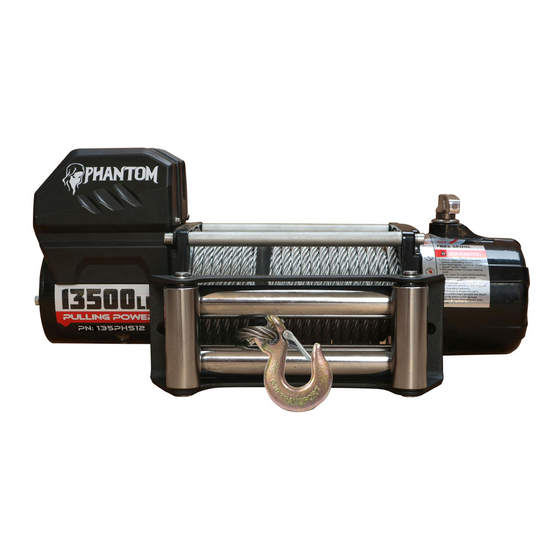
Table of Contents
Advertisement
Quick Links
Advertisement
Table of Contents

Subscribe to Our Youtube Channel
Summary of Contents for WARRIOR 135PHS12
- Page 1 ELECTRIC WINCH 135PHS12 135PHA12 Assembly & Operating Instructions...
-
Page 2: Table Of Contents
CONTENTS INTRODUCTION ..................1 GETTING TO KNOW YOUR WINCH ............1 SAFETY PRECAUTIONS .................3 GENERAL TIPS FOR SAFE OPERATION ..........4 WINCHING TECHNIQUES A-Z ..............5 WINCH ASSEMBLY AND MOUNTING ............7 MOUNTING DRAWING ................8 WINCH ACCESSORIES ................8 RIGGING TECHNIQUES ................9 WINCH WORKING DEMONSTRATION ..........1 0 REPLACING THE WIRE ROPE ............. -
Page 3: Introduction
INTRODUCTION Congratulations on your purchase of a high quality winch. We design and build winches to strict specifications and with proper use and maintenance should bring you years of satisfying service. WARNING - Read, study and follow all instructions before operating this device. - Page 4 1. This winch is engineered for maximum line pull with only one layer of cable spooled onto the winch drum (the first layer). 2. Motor: Your motor is powered by a 12/24 volt battery and provides power to the gear mechanism which turns the drum and winds the wire rope; 3.
-
Page 5: Safety Precautions
13. Snatch Block: If your winch is supplied with a snatch block that can double the pulling power of the winch, or change the pulling direction without damaging the wire rope. We recommend you to use double line and snatch block for pulling over 70% of the rated line pull. -
Page 6: General Tips For Safe Operation
top. To spool correctly you should keep a slight load on the cable while pushing the remote button to draw in the cable. Walk toward the winch not allowing the cable to slide through your hands. Do not let your hands get within 12 in. of the winch while spooling. -
Page 7: Winching Techniques A-Z
on the wire rope by as much as 50%. When doubling the line back to the vehicle, attach to the frame or other load bearing part. • The vehicle engine should be kept running during operation of the winch to minimize battery drain and maximize power and speed of the winch. - Page 8 c. Disengage the clutch to allow free-spooling and to save energy. d. Attach the hand saver hook to the clevis hook. e. Pull out the wire rope to your desired anchor point using the hand saver hook. f. Secure the clevis hook to the anchor point: Sling, chain or snatch block. Do not attach the hook back onto the wire rope.
-
Page 9: Winch Assembly And Mounting
v. Rewind the wire rope. Make sure that any wire already on the drum has spooled tightly and neatly. If not, draw out the wire and re-spool from the point where the rope is tight. w. Keep your hands clear of the winch drum and fairlead as the wire rope is being drawn in. -
Page 10: Mounting Drawing
CAUTION – Batteries contain gases which are flammable and explosive. Wear eye protection during installation and remove all jewelry. Do not lean over battery while making connections. 5. Assemble the clevis hook to the cable. Take off the pin from the clevis hook, connect the clevis hook to the cable and mount the pin back to the clevis Hook. -
Page 11: Rigging Techniques
Gloves – For handling the wire rope and hook strap. Anchor Strap/Chain – Tree saver anchor straps are made of high quality nylon with high tensile strengths up to 15000lbs. Heavy Blanket – place on the cable to absorb energy should the wire rope break. RIGGING TECHNIQUES Self-Recovery Locate a suitable anchor such as a strong tree trunk or boulder. -
Page 12: Winch Working Demonstration
WINCH WORKING DEMONSTRATION 1. Disengage the clutch by turning the clutch to the “CLUTCH OUT” position. 2. Grab the cable assembly (Part# 135001000) and pull the cable to the desired length, then attach to item being pulled. Caution: Always leave at least five turns of cable on the drum; Review winch safety warnings and precautions on page 2、3 before continuing. -
Page 13: Maintenance
6. Retract Cable Assembly onto drum, first five wraps being careful not to allow kinking, then winch cable must be wound onto the drum under a load of at least 10% rated line pull. WARNING - Only replace the wire rope with the identical replacement part recommended by the manufacturer. -
Page 14: Trouble Shooting
TROUBLE SHOOTING SYMPTOM POSSIBLE CAUSE SUGGESTED ACTION -Switch Assembly connected improperly -ReInsert switch assembly into the connector. -Loose battery cable -Tighten nuts on all cable connections. connections -Replace switch assembly. Motor does not -Defective switch -Check for voltage at armature port with Switch turn on assembly pressed. -
Page 15: Winch Assembly Drawing
WINCH ASSEMBLY DRAWING... -
Page 16: Winch Parts List
WINCH PARTS LIST Description Part # Remark 1350001 Terminal Protect 13500100 Motor Assembly 1350002 Cap Screw M10 x 35 Lock Washer Φ10 1350003 Think Flat Washer Φ10 1350004 1350005 Hex Nut M10 13500200 Break / Shaft Assembly 1350006 Bushing—Drum 1350007 Six Angle Bar 1350008 Ring Seals... -
Page 17: Specification
SPECIFICATION Rated line pull 13500 lbs (6123 kgs) 12V:Input: 4.6kW / 6.1hp; Output: 2.1kW / 2.8hp Motor: series wound 24V:Input: 6.5kW / 8.7hp; Output: 2.8kW / 3.8hp Gear reduction ratio 265:1 Synthetic rope Wire rope Ø0.39"×65.6 ' (Ø10mm×20m) Cable (Dia.× L) Ø0.4"×65.6 ' (Ø10.2mm×20m) Ø0.35"×98.4 ' (Ø9mm×30m) Drum size (Dia.×...






Need help?
Do you have a question about the 135PHS12 and is the answer not in the manual?
Questions and answers